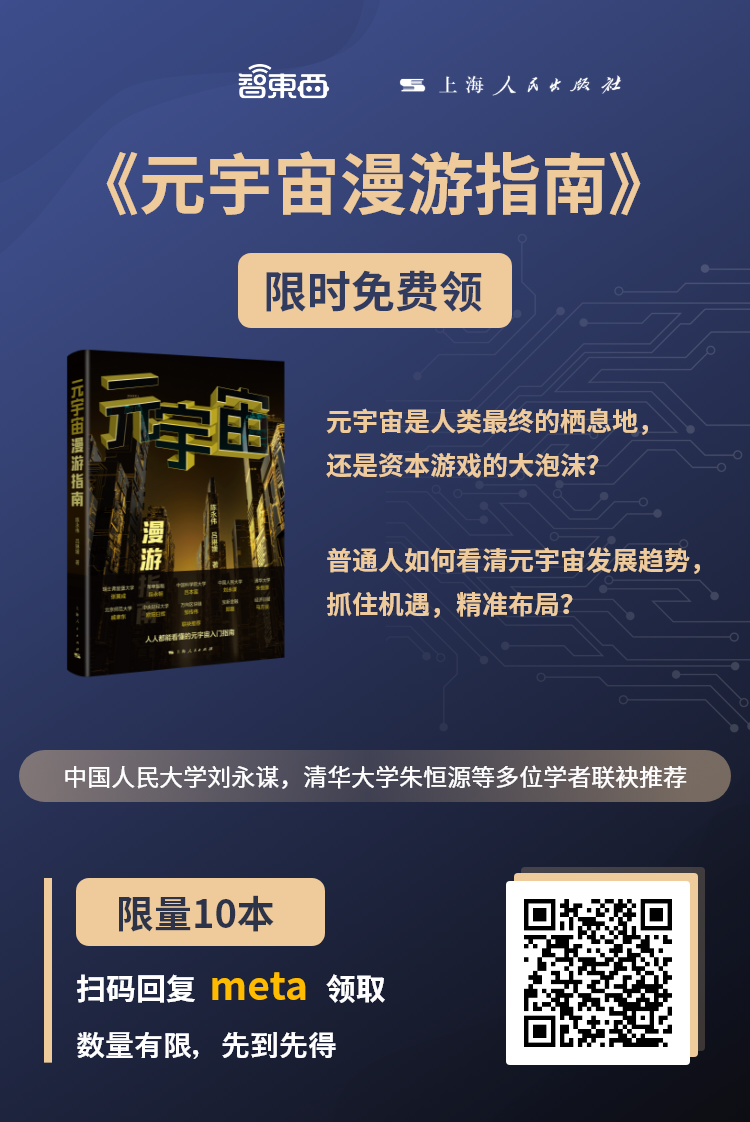
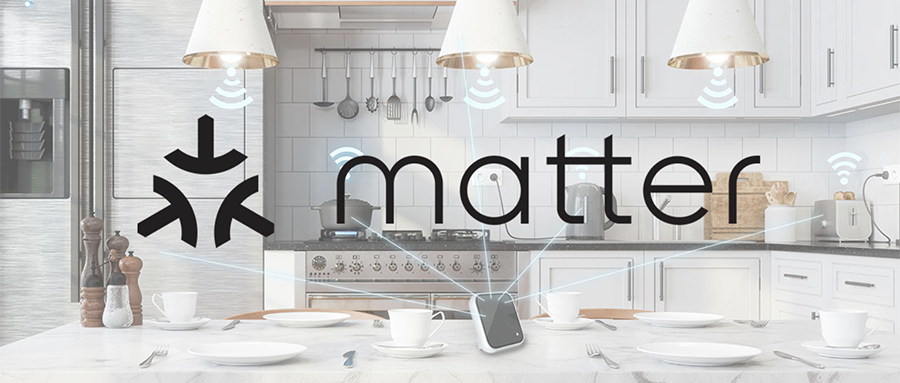
“The Matter standard has already become an essential attribute for any new (smart home) product.” Author | Cheng Qian Editor | Xinyuan
Is the smart home industry’s transformative Matter standard finally about to be implemented?
In March of this year, the Connectivity Standards Alliance (CSA) revealed on its official blog that the Matter standard 1.0 will be publicly released this fall.
On September 14, SiFive launched a hardware-software collaborative Matter standard chip solution; in July, Amazon released a toolkit to help developers build smart home devices that support the Matter standard; in June, Apple’s iOS 15.5 officially supported the connection of five devices compatible with the Matter protocol… All of this indicates that the implementation of the Matter protocol is just around the corner.
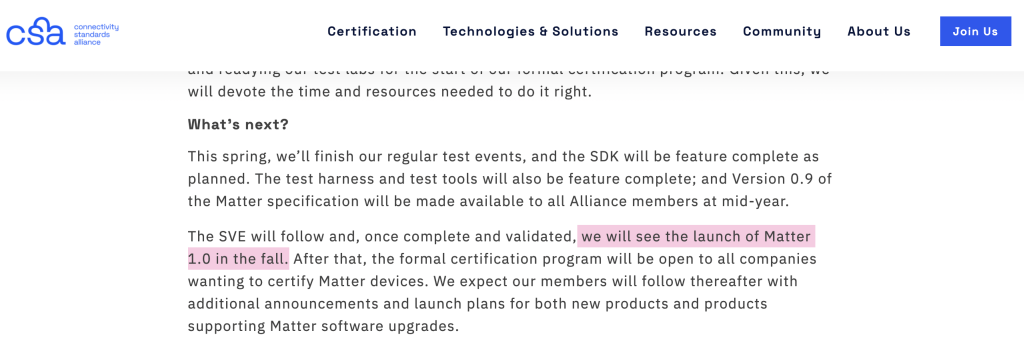
▲ Official statement from the CSA
Now, if you want to use an Apple HomePod to control an Amazon smart doorbell to open the door for guests, but find that you cannot connect, or if you want to use a Huawei phone to control a Xiaomi robot vacuum but need to download an app, this situation is still far from the perfect experience we envision for smart homes.The emergence of the Matter standard is bound to become a key variable that will disrupt the smart home market and reshape its landscape.However, this long-awaited new standard has been delayed for two years, with its release date pushed back repeatedly.
In May 2015, the CSA released the Matter standard, which is recognized as a potential unifying standard for the smart home industry. Upon its release, it received support from major foreign players like Apple, Google, and Amazon, as well as domestic companies like Huawei, Xiaomi, Tuya Smart, and Aqara. Initially, the CSA planned to publicly release Matter standard 1.0 by the end of 2020, but this has been continuously postponed, and no accurate timeline has been officially announced.
Although the Matter standard has not yet been implemented, various players have already begun to prepare intensively, launching products compatible with the standard and developing tools, to the extent that the enthusiasm can be summarized as “no Matter, no smart home.”
So, which domestic companies are well-prepared for the Matter standard? Why has the Matter standard been “all talk and no action” for the past two years? What hurdles must the Matter standard overcome to connect various smart home brands? What is the current progress of related domestic alliances?
By reviewing the movements of domestic smart home players regarding compatibility with the Matter standard over the past year and engaging in in-depth discussions with industry insiders, we attempt to find answers to these questions.
This article offers insights:The development of smart homes from individual products to whole-home solutions is a long-term process. The industry standard for smart homes, Matter, is also progressing.Recommended premium report “Smart Home Industry Research Report – Moving Forward, the Future is Promising”, available by replying with the keyword [Smart Things 267] in the public account chat.
01.53 Companies Undergoing Standard Testing14 Have Submitted ResultsWe can envision a potentially disruptive smart home ecosystem experience after the Matter standard is implemented: you can use an Apple HomePod to control Amazon’s smart doorbell, a Baidu smart speaker to operate Xiaomi’s smart lock and camera, and an Apple phone to control various brands of robot vacuums…The Matter standard is based on the most commonly used IP protocol in the internet world, enabling smart home devices to interconnect across mobile application systems, cloud services, and IoT embedded systems, simplifying the development costs of various smart devices while lowering the usage threshold for end consumers. Consumers only need to scan the QR code on the device to customize and add it to their smart home system.
However, after two years of preparation, the Matter standard has yet to release version 1.0. What have its participants been busy with?
1. Multiple Tests Extend the Timeline
In July of this year, the first phase of the CSA’s SVE specification verification testing was successfully completed. In simple terms, this involved testing the interoperability, stability, and security of products from different manufacturers. In August, the CSA’s annual report indicated that as of 2021, the Matter standard had 53 companies and 134 devices undergoing certification testing.
The CSA’s official website shows that these devices include smart bulbs, plugs, switches, smart locks, thermostats, sensors, TVs, and various other smart home devices, and products from certified companies will be shipped to users immediately after the Matter standard is released.
Additionally, the SUV specification verification testing not only tests the usability of related platforms and devices but also verifies the operability of the CSA’s testing and certification processes and tools.
Currently, the second phase of virtual testing and specification verification is also underway.
These tests are indeed the final steps toward the implementation of the Matter standard; however, due to the numerous manufacturers and devices involved, the testing process has been further extended.
2. 14 Domestic Players Announce Support for Matter Standard Products
According to publicly available information compiled by Smart Things, 14 domestic manufacturers have “launched” products that support the Matter standard or announced that their products will support the Matter standard.
These manufacturers cover upstream and downstream players in the smart home market, including chips and devices.
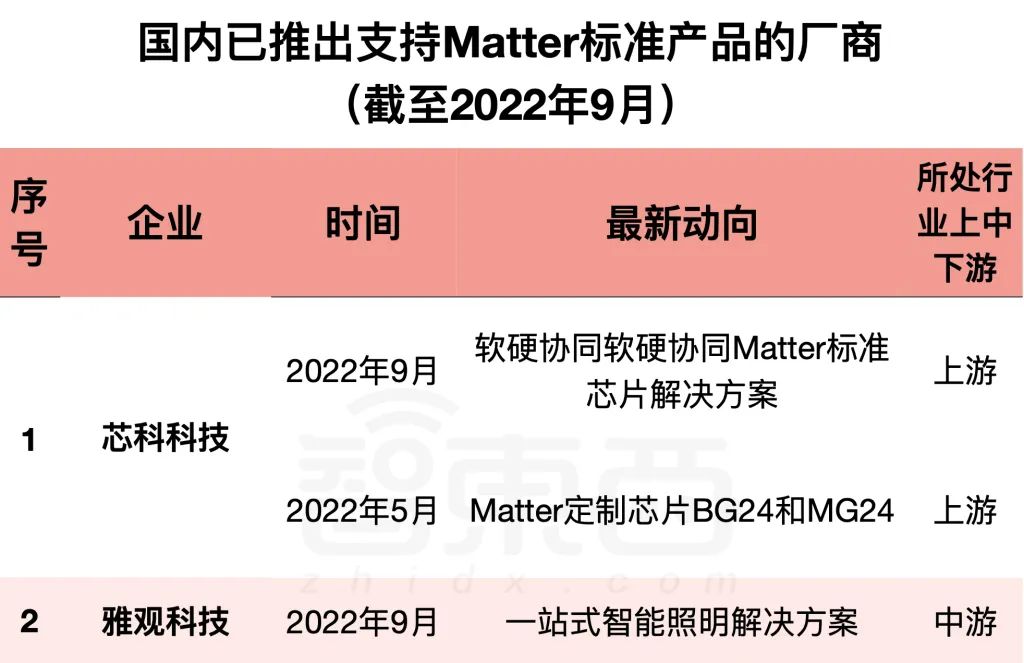
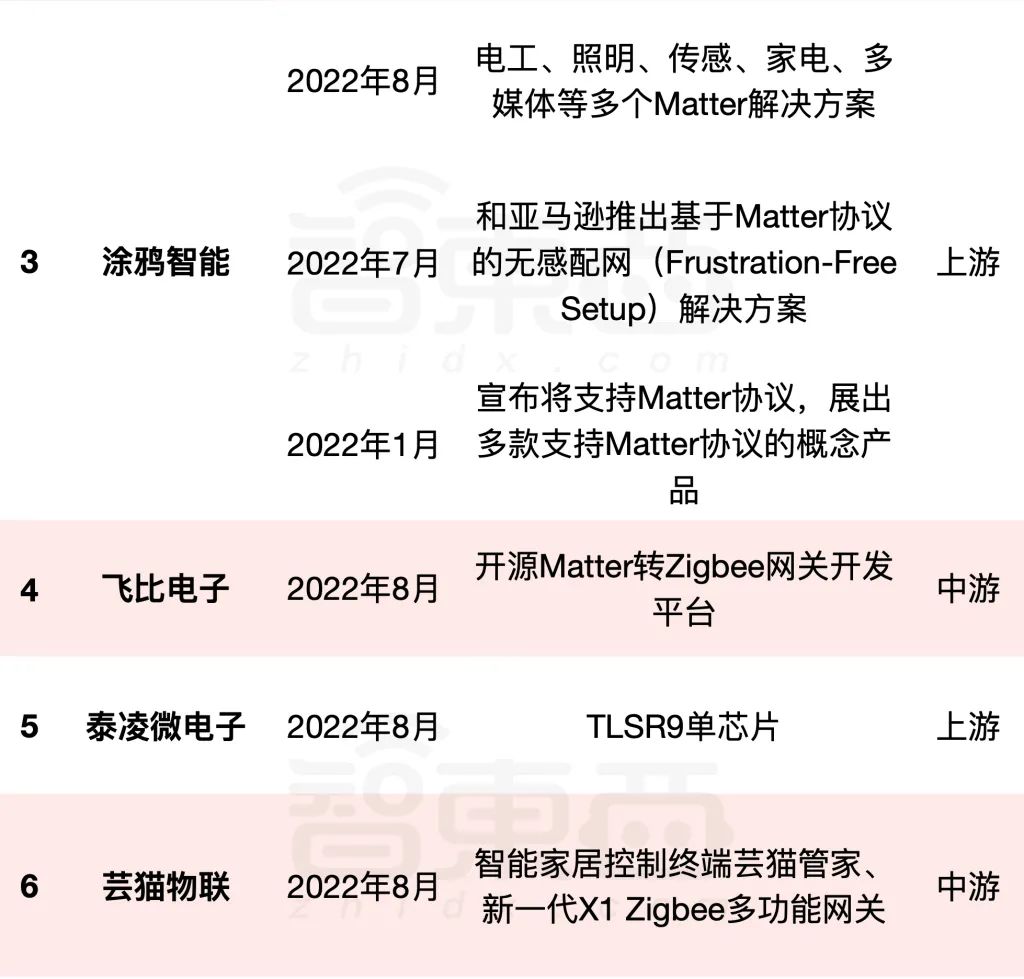
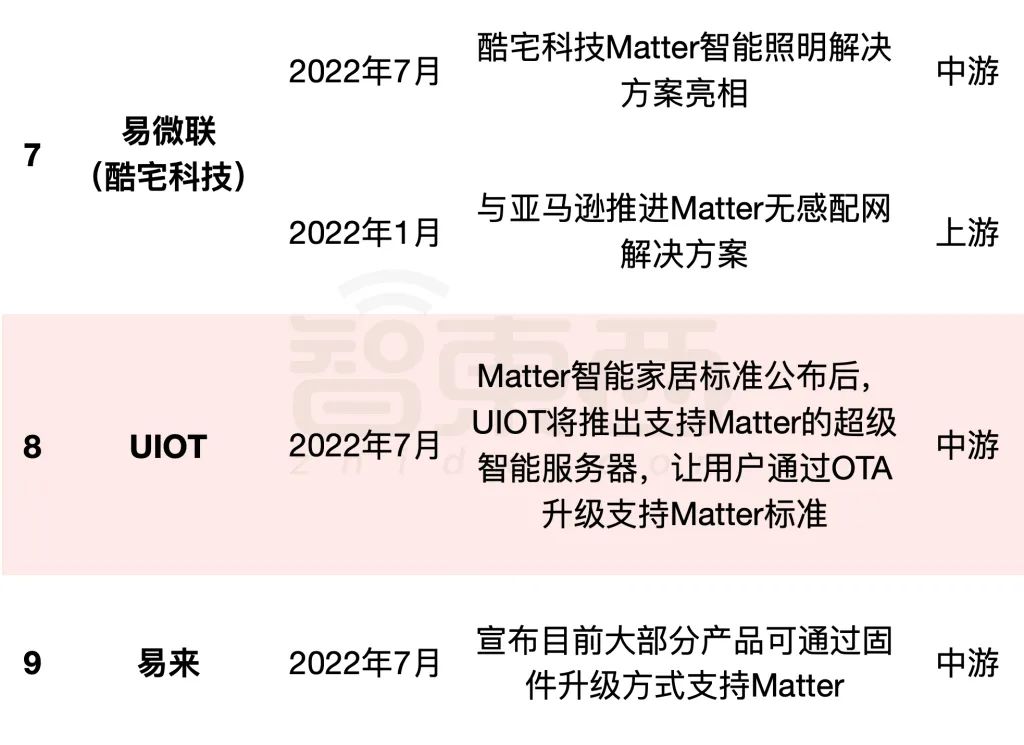
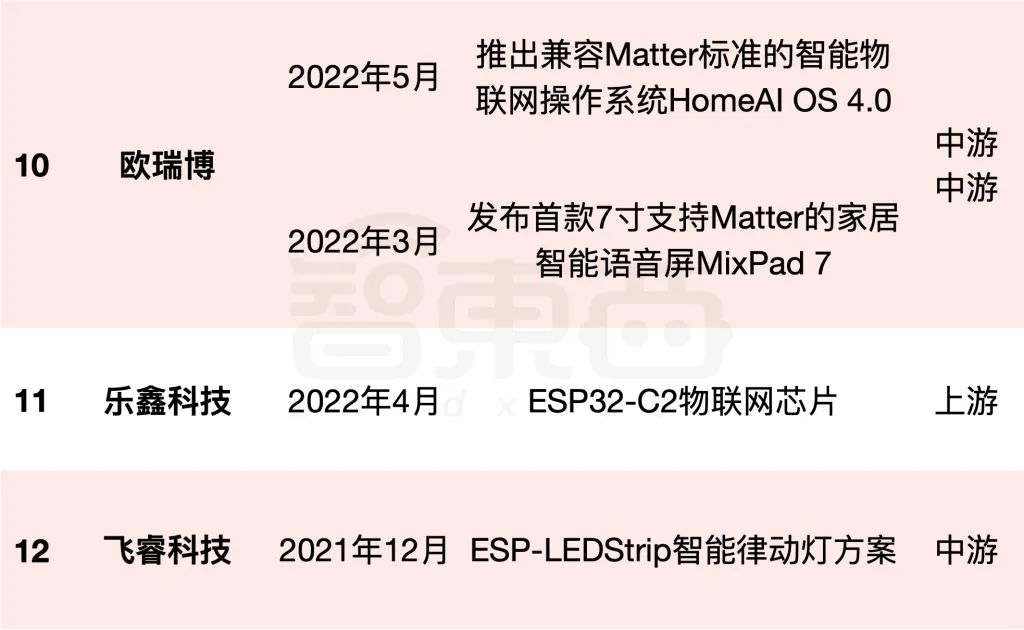
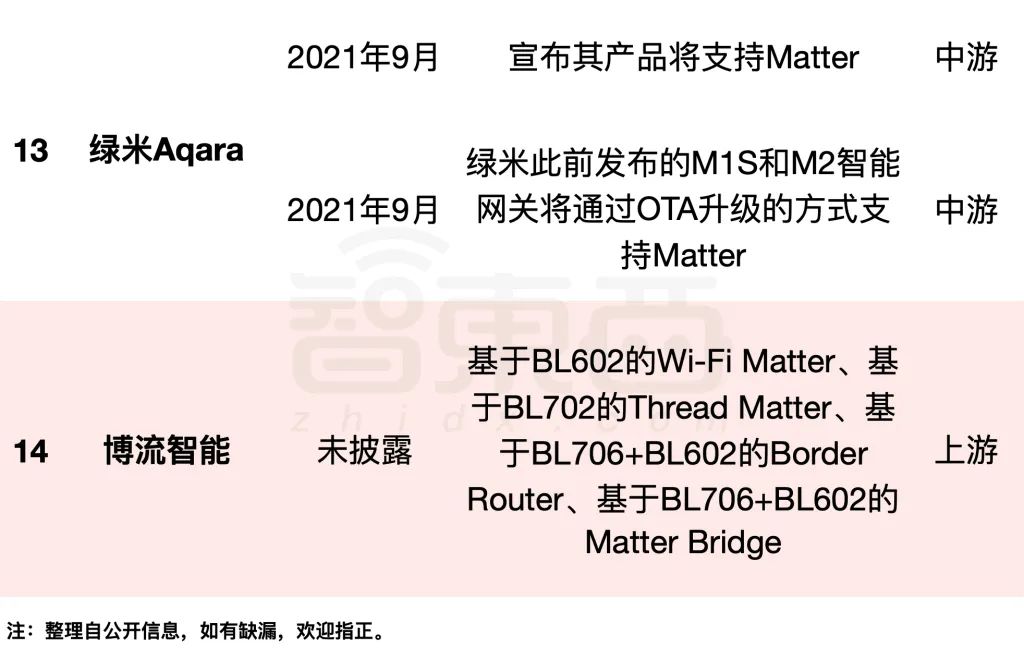
▲ Domestic manufacturers that have launched products supporting the Matter standard (as of September 2022) (compiled from public information; corrections are welcome.)
In the smart home market, smartphone manufacturers and major appliance giants have yet to launch related products. Midea’s IoT International Smart Business Director Chen Chang revealed: “These players will choose to optimize their models and launch related products after the Matter standard is implemented.”
However, in the current situation where the Matter standard has not yet been implemented, what can these products do?
Chen Chang told Smart Things that these products are still in the planning stage, and truly Matter-compliant products are not yet available for market release.
Currently, most of the products launched by these manufacturers still use connection protocols like ZigBee and WiFi. The ZigBee protocol can be considered a “foundational” presence in the smart home industry, with advantages such as low power consumption, low cost, and low latency. The Matter standard is essentially derived from ZigBee, and the CSA was originally the ZigBee Alliance.
After the Matter standard is released, these devices can be upgraded via OTA to support compatibility with the standard, eliminating the need for users to purchase new devices.
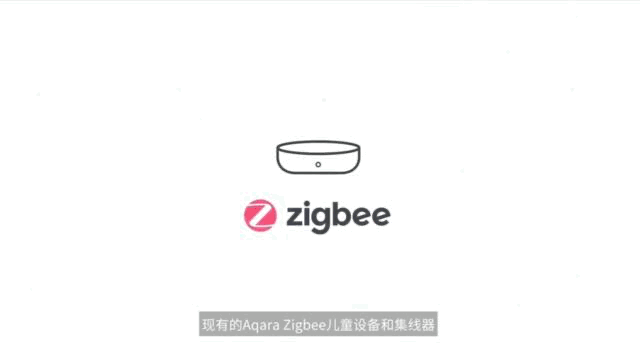
▲ Aqara devices compatible with the Matter protocol (animated image captured from the 2022 Works With conference)
Aqara’s overseas product line manager Wei Peng explained: “If the Matter standard is the language that devices use to communicate with each other, then ZigBee and Thread are the infrastructure they use for communication.”This is also the key reason why these products can be upgraded via OTA to support compatibility with the standard, without requiring users to purchase new devices.
It is worth mentioning that devices such as servers and gateways generally have lower replacement frequencies and higher replacement complexities.
This also serves as a way for manufacturers to seize a first-mover advantage in this market.
02.Standard Unification is an Inevitable TrendThe Matter Standard Benefits Multiple Parties
The smart home industry has existed for nearly 20 years, and many people have been optimistic about it. From various giants to startups, they have all rushed into this track. However, the lack of unified standards and device fragmentation have been key issues hindering the development of this industry.
The importance of the Matter standard to the smart home industry can be gleaned from its name. Matter literally means “substance,” which is considered the foundation of existence in the world, and the significance of the Matter standard is similarly foundational, viewed as a cornerstone of the Internet of Things.So, what challenges can the Matter standard address that stand in the way of the smart home industry, players, and consumers?
1. Major Smart Home Players Competing for Territory
Smart homes are transitioning from consumer aspirations to tangible devices in homes.
The number of devices in a household is increasing, and how to achieve interconnectivity between different devices, allowing the smart home in a user’s home to become a “whole,” without needing different apps or other means for independent control, has become a constraint for smart home manufacturers.
In the early stages of the smart home market, some players began building ecosystems for their products.
However, due to the immaturity of connection standards and communication protocols at that time, different smart home players built their own ecological barriers. This approach has led to widespread consumer dissatisfaction.
2. Small and Medium-Sized Smart Home Manufacturers Risk Losing Advantage
A question arises: how many smart home devices does a household actually need? From the entrance, living room, bedroom to bathroom and storage room, various smart home devices are needed to meet user demands, ranging from smart toothbrushes and table lamps to smart TVs and refrigerators.
Behind this lies the fact that a single manufacturer cannot produce all products, and products that can connect better with other brands will become more favored by consumers.
As the smart home market matures, smartphone players have also become significant participants in the smart home field, such as Xiaomi and Huawei. In contrast, the smart home ecosystems of major players are more complete, which may cause many small and medium-sized manufacturers to lose their competitive edge.
3. Limited Consumer Choice Freedom
From a consumer perspective, when choosing smart home devices among smart appliances and new appliance categories, users may choose different brands influenced by brand power and product quality. However, in addition to considering product performance and quality, they also need to consider compatibility with existing smart home devices, which can limit their freedom of choice.
It is evident that introducing a unified industry standard is beneficial for both manufacturers and consumers.
Wei Peng stated that a year ago, when the Matter standard was not yet mature, many Aqara users had already provided feedback requesting that their products support the Matter standard. This year, the Matter standard has also become a necessary attribute for any new (smart home) product.
03.The Matter Standard is a Challenging Yet Correct Move
So, what levels can the Matter standard achieve interconnectivity among devices? We may find answers in the reasons for its repeated delays in announcement.
First, a universal standard must consider multiple needs.
The Matter standard is an application layer specification that can run on any device supporting IPv6. This internet protocol makes it possible to connect an increasing number of smart home devices. Liu Yang, an expert from Hebei Unicom’s network department, once stated in an interview that IPv6 can provide up to 2 to the power of 128 addresses, a number sufficient to assign an IP address to every grain of sand in the world.
This standard requires the establishment of a universal object model for smart home products, allowing these products to “speak the same language” in terms of functionality and operation, which also imposes high standards and strict requirements on code quality and stability. Therefore, the CSA needs to release a commercially viable SDK software development kit. “This is also why the CSA is conducting various tests and verifications,” Chen Chang said.
Second, balancing the core interests of different manufacturers.
He added, “The CSA also wants to expand its ecosystem and influence.” Currently, over 50 companies are involved, and this number is expected to continue to grow. Testing and certifying all 130+ devices will take a considerable amount of time. The communication costs regarding the core interests of each manufacturer will also increase.
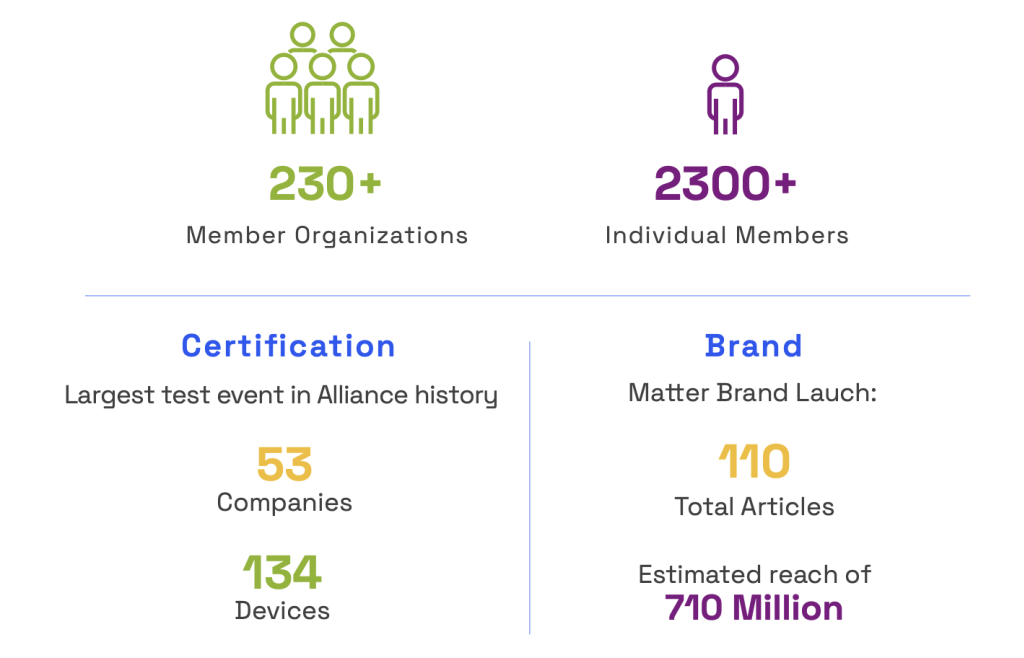
▲ Number of manufacturers and devices tested by the CSA
Finally, finding common ground among existing protocols.
The Matter standard does not aim to establish a new set of rules for the smart home industry but seeks to find commonalities while respecting differences based on existing protocols. Chen Chang revealed that some local connection protocols of the Matter standard need to be redefined, meaning that it must maintain efficient connections while ensuring that each node has its own communication method.
This work does not solely focus on preserving commonalities; the CSA also needs to rewrite various protocols between smart home devices and communication protocols, and modifications are required at the physical layer as well. Therefore, he believes that the repeated delays of the Matter standard are normal.
From the perspective of the Matter standard itself, the influx of smart home players is inevitable.
However, for domestic smart home players, there is an additional advantage: the leading parties of the Matter standard are the three giants—Apple, Amazon, and Google.
Chen Chang stated: “I believe that Matter is not just a protocol standard; it is also a certification system.” Devices certified by the Matter Alliance will naturally achieve interconnectivity. In the future, products that can connect to the Matter standard will be able to integrate into these three major platforms, presenting a significant market opportunity for smart players.Therefore, at the recently concluded 2022 Works With developer conference, Tuya Smart’s Asia-Pacific General Manager Luo Zhijun stated, “Once the Matter standard (1.0) is announced, Tuya Smart’s Matter solution will be ready.”Meanwhile, Aqara’s overseas product line manager Wei Peng also revealed that in the second half of this year, Aqara plans to launch its first product compatible with the Matter standard.
In fact, whether for smart home manufacturers or consumers, the interconnectivity of smart home devices is overwhelmingly beneficial, as it increases consumer choice and enhances the competitive advantage of smart home manufacturers.
However, the products currently launched cannot validate the effectiveness of their integration with the Matter standard; only when the Matter standard is truly implemented can this be tested.
04.Domestic Version of the Matter Standard Progressing RapidlyStill Shackled by Interest Games
Every step of the Matter standard’s progress is eye-catching. In contrast, why is the related standard in China not as prominent as Matter?
As early as December 2020, 24 academicians and major domestic smart home players, including Alibaba, Baidu, Haier, Huawei, the China Academy of Information and Communications Technology, and China Mobile, jointly established the Open Link Association (OLA). As of December 2021, the OLA has approved 128 member units.
Midea’s IoT Technology Director Chen Ting stated: “Like the CSA, the OLA aims to establish a standardized system for the smart home market, build a unified connection standard for the Internet of Things, and solve the fragmentation issue of the Internet of Things, truly achieving intelligent interconnectivity.”
However, from its development process, the OLA’s progress has been quite vigorous.
The OLA’s official website shows that 37 standards are currently being advanced, including performance testing specifications, safety technical requirements, and cross-platform access specifications. Additionally, there are white papers on smart home lighting connectivity, family edge computing based on smart home interconnectivity, and full-house intelligent scenario white papers.
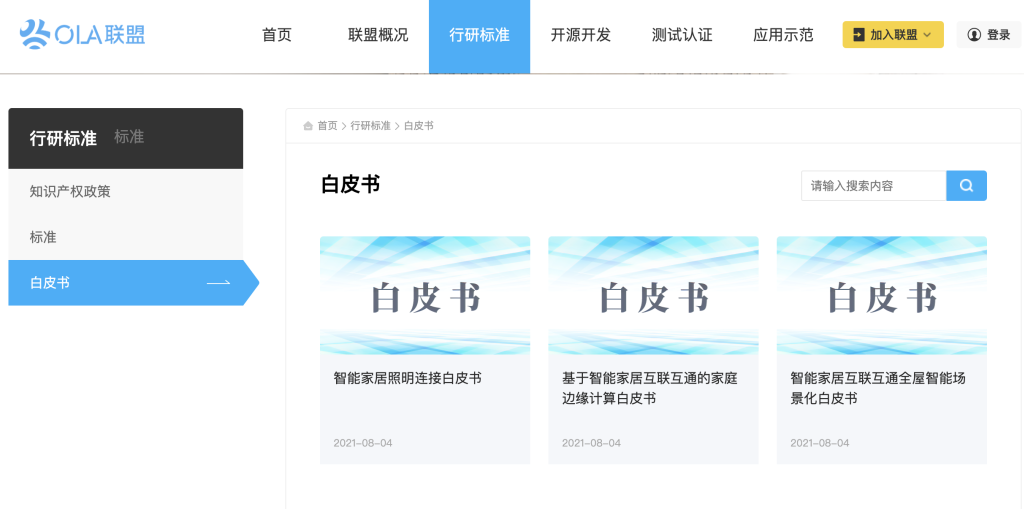
▲ White papers publicly released by the OLA
In terms of product testing and certification, the OLA has also made significant progress. In May of this year, the OLA’s smart home committee held its third joint testing event, covering all test cases for WiFi products.
However, in terms of commercialization progress, domestic alliances still lag behind the Matter standard. As a key to smart home interconnectivity, how to balance the interests of different manufacturers remains a challenge for the OLA. The Matter standard has already reached a consensus on balancing interests among different players, and even though the release of standard 1.0 has been repeatedly delayed, its development progress has already shown initial results.
Midea’s Whole House Solutions and Ecosystem Minister Tan Guoliang stated: “The domestic OLA is also actively promoting productization and pilot applications, hoping for more manufacturers to participate and accelerate commercialization.” The consensus on the Matter standard benefits from the leadership of the three giants: Apple, Google, and Amazon.Manufacturers such as Midea, Huawei, Xiaomi, Vivo, Nanjing IoT, Infineon, Orvibo, and TCL are participating in both alliances. In his view, this is not contradictory; from both consumer and industry perspectives, solving the industry pain point of isolated devices is the greatest driving force for these alliances.
Regardless, achieving interconnectivity among devices and enhancing user experience is an unavoidable topic for smart home players, so the unification of standards is merely a matter of time.
05.Conclusion: Domestic Players Are ReadyThe Launch of the Matter Standard Remains Uncertain
Both smart home manufacturers and ordinary consumers have long suffered from the inability of the Internet of Things to interconnect. Therefore, the unification of smart home standards is undoubtedly one of the inevitable trends in the development of this industry.
Typically, the importance and difficulty of a task are often positively correlated. The Matter standard aims to unify thousands of smart home players under one standard, which is quite challenging. Beyond technical reasons, the launch of this standard involves various interests, casting a significant question mark over the advancement of the Matter standard.
As of now, whether the Matter standard can be implemented as scheduled this fall remains uncertain. The active preparations of domestic players for the Matter standard undoubtedly add weight to the importance of this standard.
This article offers insights:The development of smart homes from individual products to whole-home solutions is a long-term process. The industry standard for smart homes, Matter, is also progressing.Recommended premium report “Smart Home Industry Research Report – Moving Forward, the Future is Promising”, available by replying with the keyword [Smart Things 267] in the public account chat.
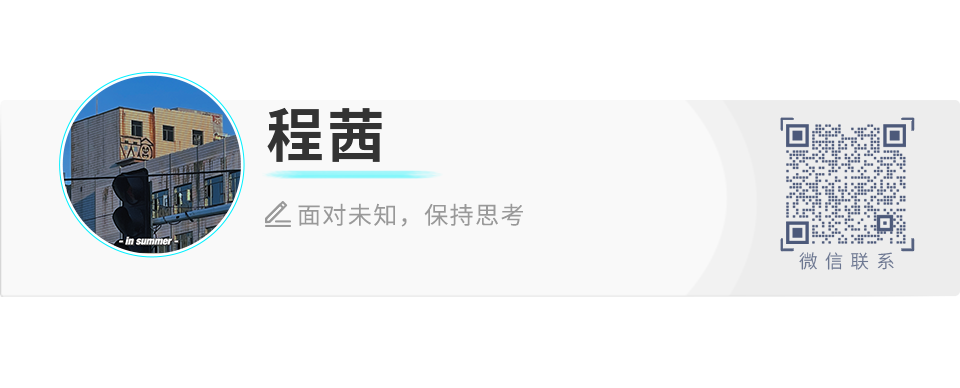
(This article is original content from NetEase News • NetEase’s special content incentive program signed account [Smart Things], unauthorized reproduction is prohibited.)